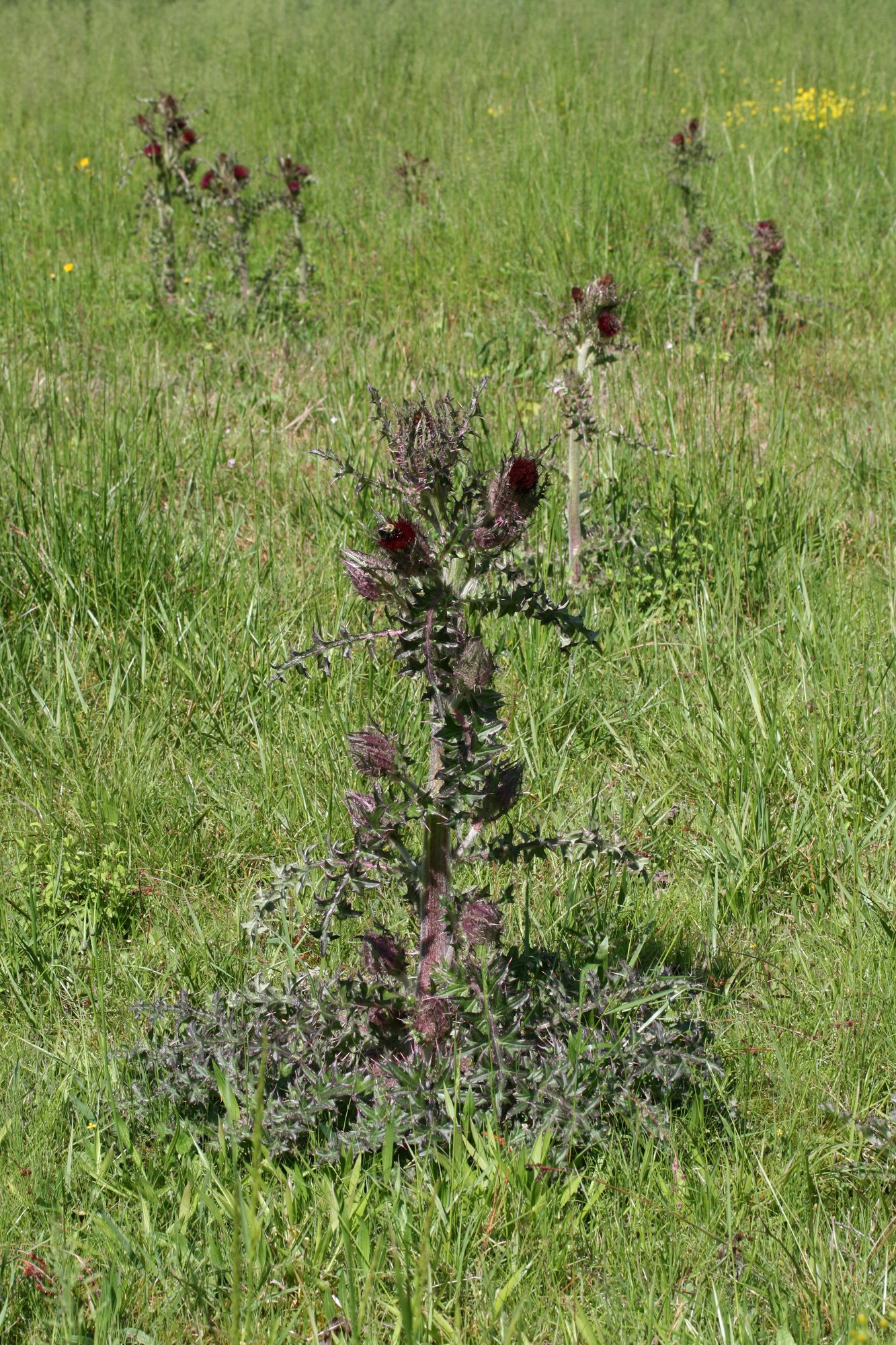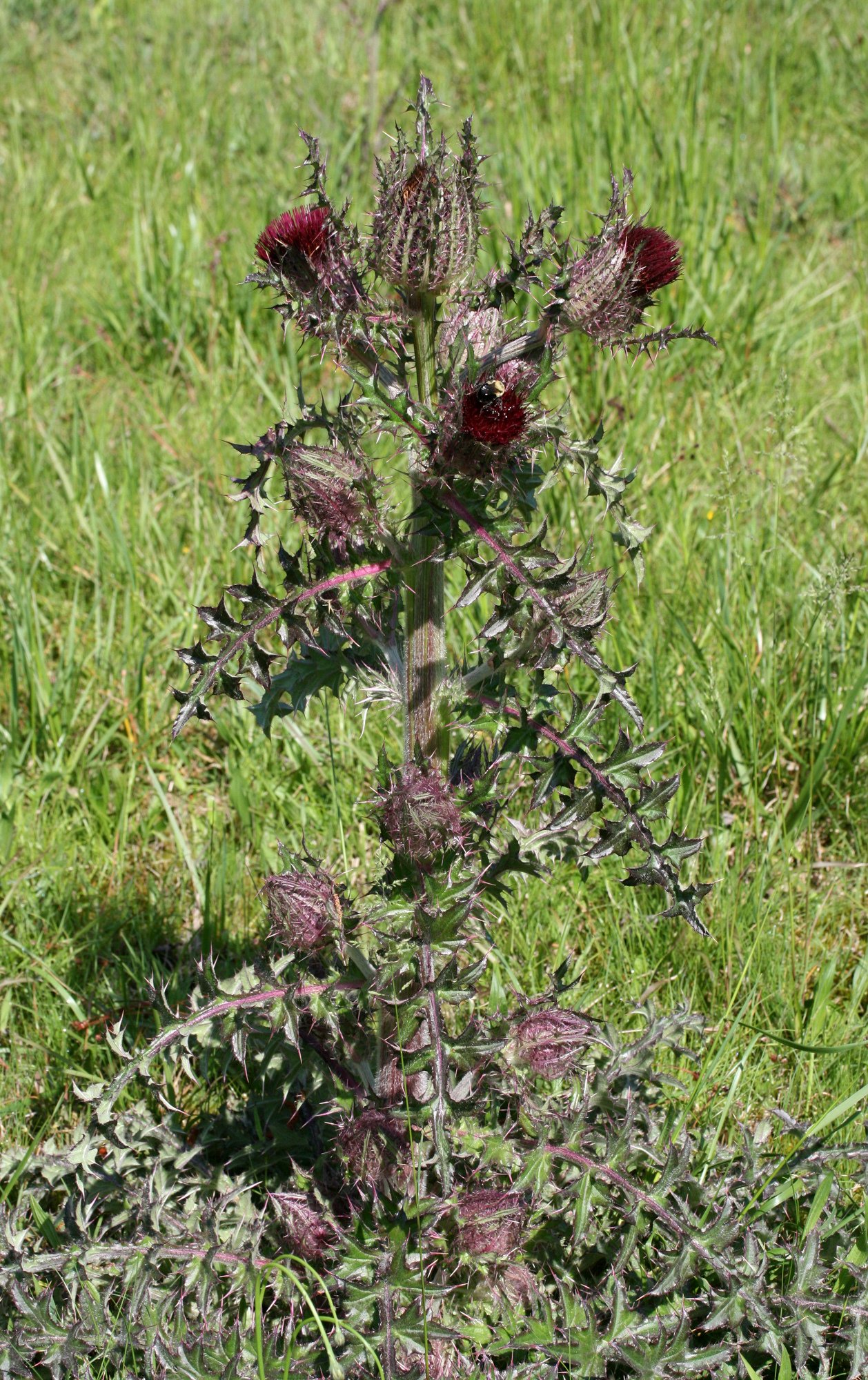During tough weeks like this one, I’m very thankful for moth friends.
Horrid Thistle (Cirsium horridulum horridulum). Cherokee County, Alabama, US. April 2023. Yellow and red color variants found at the same general location.
A Prickly Disposition
Cirsium horridulum, also known as The Horrid Thistle, is an undervalued and often maligned plant which is native to the Eastern United States. It can be found in salt marsh edges along coastlines, but it also grows and spreads quite readily in sunny meadows and lawns—reaching heights of up to five feet (152 cm) tall with basal leaves of around one foot (30 cm) in diameter. As a result of its success in fields and lawns, it has frequently been labeled a "pasture weed" in parts of the US. Its flowers come in a variety of colors, including white, red, pink, yellow, and purple, and it is armed on most surfaces (from flower bracts to leaves to stem) with defensive spines which effectively ward off most mammalian herbivory.
While its populations are secure in much of the Southeast, The Horrid Thistle faces a number of threats. It is listed as endangered in Connecticut, Pennsylvania, and New Hampshire—and is considered threatened in Rhode Island. Its disappearance in these locations is thought to be caused by a combination of both habitat loss and the introduction of the nonindigenous Thistlehead Weevil, Rhinocyllus conicus—first introduced to the East Coast US in the 1990s in order to control several introduced, invasive thistles.
Despite its somewhat unsettling appearance, pain-inducing prickliness, and eagerness to spread through fields and salt marshes, the good that this species can do for our indigenous ecosystems is palpable. Its outward disposition belies its true nature, and if we just take the time to look a little deeper there is so much to learn! Not only is The Horrid Thistle a host plant to multiple species of insects (which include the likes of the Painted Lady Butterfly and the Little Metalmark Butterfly), but it also rewards a plethora of pollinators with high value nectar, provides songbirds with nutrient-rich seeds, and supplies crucial nesting material for native bees. Its gifts to wildlife are truly bountiful, making it a perfect plant for those hoping to start a pollinator garden (in these locations)!



To be honest, I’ve struggled a lot over the past week to put together a blog which would capture both the beauty of this plant and the strange sort of kinship I feel for it. There is a wave of deference that washes over me whenever I’m in the presence of this plant, and I can’t quite explain it. It has a refreshing forthrightness with which it asserts itself, sternly asking us to be mindful of boundaries—while at the same time asking us to challenge our pre-existing beliefs and reserve our judgments for when we have a broader (and clearer) perspective.
I’ve always had a penchant for outsiders (like The Horrid Thistle), finding myself sympathizing with fictional antiheroes—with their complicated backstories and unexplored gray areas—being utterly frustrated at society’s polarized views and its unwillingness to delve any deeper than surface labels like “good” and “bad”. The fact of the matter is that our superficial gazes often fail to ascertain the inherent value in wildlife (and in humans for that matter), and as a result we deprive ourselves of so many opportunities for joy.
Aleuria cestrica, Etowah County, Alabama. September 2022.
Born of Rain, Dressed in Flame
During late August 2022, only a few weeks after we had moved back to Alabama following a year-long journey to New England and back down through the mid-Atlantic, the entire family fell ill with the Omicron variant. I’m not exactly sure why, but I was the last to start exhibiting symptoms or test positive for the infection. It was pretty much impossible to isolate myself from my infected partner inside a 36’ RV, but I tried my best to spend as much time as I could sitting outside when I wasn’t providing him with fever reducers, water, and moral support.
Fortunately for me, the unusually balmy and mild summer (for Northeast Alabama standards) made it a lot easier for me sit outside for most of the day without overheating . The torrential rains that have become the norm these days in the Southeast served as a regular reminder that many fungi were flourishing out in the forest at that time—and that there was not much I could do to break myself away from my caretaker role to take advantage of that. What I didn’t realize at the time was that there were some very interesting fungi within just a few footsteps of where I had been sitting.
A few days passed, and my partner began to stir from his fevered state—while I had begun to feel more foggy and flushed (and panicked that I wasn’t actually going to escape this virus). My energy levels had dropped to well below my usual by that point—which is A LOT. Despite this, I was still trying to convince myself that I was going to magically evade getting “the full-on ickies”. I willed my wobbly body to amble around the RV in search of interesting things—anything—to distract me from what was on the way. In my restrained meanderings, I noticed long, rain-soaked grooves had formed in the iron-rich soil below the pole barn (due to the heavy rains and the gutter positioning). My eyes reflexively searched the still-damp soil for signs of fungal life.
And there they were—unapologetically announcing their existence—born by rain, dressed in flame. I dizzily stooped to admire them, photograph them, and probably even said a “hello” and a “thank you” before my analytical brain began to take the reigns.
Surely this was something in the Pezizales order. The only thing that came to my mind at the time was Aleuria aurantia, the Orange Peel Fungus. The habit was right, but these were much more tiny than any of those that I had encountered. I definitely need the help from the mushroom community to figure these out!
I vaguely remember posting my photos on iNaturalist, tentatively labeling them as “Family Pyronemataceae”, before finally succumbing to “the full-on ickies” for several days. Even in my delirious state, my brain continued to try to piece it all together, but true progress would just have to wait for another day.
Once I began to recover, I posted my photographs to several mushroom identification groups and even my own personal Facebook page, stating that I thought these were possibly some “weird Aleuria”. Fellow enthusiasts were pretty quick to correct this thought or suggest other genera. Being an RSDer, I felt pretty embarrassed by my mistake—and quickly thanked everyone for their suggestions. They had to be right. How could I possibly be right? My experience surely pales in comparison to theirs.
Whilst having these online interactions, I was contacted by Rosanne Healy from the University of Florida, who researches fungi from the Pezizales order—and it turned out that she wanted to take a closer look at them (via DNA sequencing and microscopy). Once I had achieved a negative rapid test result, I collected some fungi samples from the original location, packaged them carefully, and shipped them off to her address in Florida. In the meantime, I decided to leave my ID at “Family Pyronemataceae” due to a split in community suggestions. The following are from my followup conversations with Rosanne:
9/13/22: Microscopically, it looks like Melastiza. Beautiful spores. I'll keep you posted when I get sequences.
11/15/22: I am sorry for not getting back to you - because your fungus is rather unique for GenBank submissions! The ITS was only 94% similar to Aleuria cestrica, and the LSU was 98% similar to Aleuria bicucullata. In the Pezizales, the ITS sequence should be at least 97% similar to be regarded as conspecific, so yours is pretty different! LSU is a more conserved region, so sequences should be at least 99% similar to be conspecific. Sooooooo, we need to do more work on yours to compare to species in the Aleuria and Melastiza genera to see if it morphologically matches one of those.
04/07/23: Hi Flown, I finally figured this one out! It is Aleuria cestrica! Pretty rarely found, but described from Pennsylvania. Such a great find!
Upon hearing the final verdict this past month, I was excited—but honestly a bit shocked to hear that my first reflexive ID was the best guess out of any. A wave of emotions passed over me—the most noteworthy of them being something akin to self-abandonment.
What makes me so quick to deny my own instincts? Why do I hold so strongly to the false belief that other people are less capable of making mistakes—and why am I so quick to fawn to anyone and everyone who challenges my thoughts or perceptions? Isn’t being wrong a part of being human? Isn’t it also an integral part of learning and discovery and science in general? Why do I always feel like an impostor? Would it be so bad if I were to place some faith in myself at the risk of being wrong?
Like most strong emotions, it’s been really hard to get these dislodged from my brain. I know that many scientists cringe at the anthropomorphization of nature, but I find a lot of comfort and connection in this practice. I could not help but imagine what Aleuria cestrica would say to me if it had a voice:
I will not extinguish my flame for anyone. I do not require discovery to affirm my existence, and I am extraordinary even when I am overlooked.











